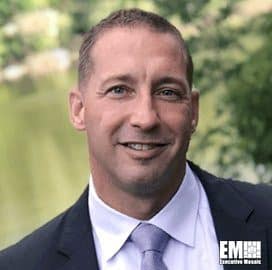
Paul Decker,
President of Defense and
Intelligence, Parsons
Member Profile: Paul Decker, President of Defense and Intelligence for Parsons
Paul Decker, president of defense and intelligence for Parsons Corporation, recently spoke with the Potomac Officers Club in an exclusive Executive Spotlight interview, during which he discussed his mission-first leadership approach and his ideas for improving vital federal processes, as well as the moral and ethical implications of rapid technological innovations. Decker, who has spent the last four years climbing the ranks at Parsons, previously served in high-level cybersecurity leadership roles for Secure Mission Solutions, Northrop Grumman and Defense Advanced Research Projects Agency.
What can you tell us about your background and how you’ve been able to adapt to the ever-changing challenges of the federal landscape over the course of your career?
“Early in my career, I proudly served in the U.S. Marine Corps, where I directly supported and implemented capabilities and strategies to support government needs as they evolved after September 11th. This experience was impactful in learning how to quickly adapt to threats and operate in uncertainty, and it is a lesson I’ve carried with me to my present position serving as president of the Defense and Intelligence business at Parsons Corporation. My diverse experience on both military and civilian sides has also allowed me to see beyond the financial performance, to feel connected to the mission and have a stake in the mission outcome. If you and your team know the importance of the mission, you are in tune with your customers and you continue to innovate, you’ll be able to make a meaningful difference and everything else will follow.
In recent years, I’ve witnessed Parsons go through a tremendous transformation that allows us not only to adapt, but to get in front of the changing federal needs by actively expanding our defense and intelligence portfolio to become a technology leader in global security and critical infrastructure. We quickly organized and integrated the best-of-breed cultures, technologies and processes from strategic acquisitions to rapidly pivot our business to high-growth markets in space, cyber, electronic warfare and integrated solutions.”
How would you describe your management style and core values towards building a winning culture?
“I work to embody the servant leadership mindset. I prioritize diverse inputs, teamwork and partnership. I have assembled the best team, and I trust that team to move us where we need to go. A large part of this approach includes getting comfortable with risk and ambiguity, and creating fun, loose environments that allow for our teams to be creative and collaborative, while also remaining laser focused on the end-mission we’re supporting, or the problem we are solving.”
If you were given free reign to enact changes in the federal landscape, what are the first three changes you would implement and why?
“Our adversaries don’t know the notion of OCI, and they don’t face bureaucratic obstacles among other things. Innovation taking place in industry needs to get into the government at the speed of relevance. To keep up with the technologies of competing nations around the globe, changing federal buying habits is critical. Investing in stove-piped systems no longer makes sense when technology is changing at the speed of light and new systems need to be integrated and updated continuously. Commercial companies, like Parsons, are able to provide customized mission solutions to meet government needs with a faster timeline and magnitude, and less cost than legacy programs.
We’ve seen a tremendous change to the overall talent landscape. The federal government has struggled with recruiting a young, diverse workforce, and still requires candidates to have over 15 years of experience. With older employees retiring and younger generations entering the workforce, many contractors find themselves on the hunt for skilled employees. A strategic and meaningful partnership is needed between the federal government and the industry to start embracing a new approach to attracting and retaining talent while also training and upskilling personnel. Good examples would be skill-based assessments versus required years of experience, candidates that offer 80 percent solution coupled with on-the-job training, flexible schedules and other creative solutions to fill talent gaps. As a country, we need to build a stronger talent pipeline. Focusing on promoting STEM education in youth will go a long way in developing the future.
There is a disparity between the number of cleared professionals and the number of unfilled positions requiring a clearance – critical to our national security. An accelerated clearance process is needed to close the gap. What now takes months needs to take weeks. Across the federal landscape, we also need to unleash remote development and perform last mile development and integration in the secure environment.”
With emerging technology influencing the federal government and industry more by the day, what are some of the challenges on the business side of innovation that aren’t always discussed as often as they should be?
“Innovation requires risk. In a world desperate for new solutions yet resistant to change, we need to empower those driving innovation – risk-taking should be rewarded and not frowned upon.
As leaders, we can’t forget about our corporate responsibility and our moral compass as we navigate through the explosive growth of emerging technologies. A lot of technologies offer great benefits, but we also need to ensure they are used responsibly and that we are prudent about possible malicious exploitation of these technologies. We must understand the full array of effects and consequences and manage risks appropriately. Security and responsibility must be the underpinning facets of innovation.
We also have to consider the ripple effect of changes that may come from a new innovation. We may create a new ‘latest and greatest,’ but then we need to make sure everything else can integrate and be compatible with the latest and greatest. It is not just the initial innovation that costs money and impacts our lives, it’s also everything that directly interacts with that innovation.”

Category: Executive Profiles




